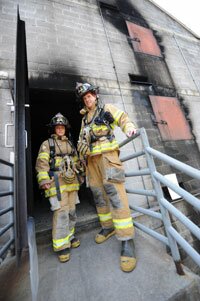COVER- Alarming: Most smoke detectors don't detect deadly smoke
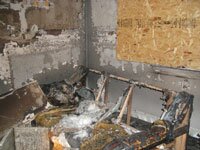
The charred living room at 2208-B North Berkshire Road shows the horrifying damage inflicted by a housefire.
PHOTO BY COURTENEY STUART
Imagine a room filling with smoke billowing from a smoldering couch. Visibility becomes increasingly compromised, but not enough to fully obscure a round white device affixed to the ceiling. It's a smoke detector. In fact, it's a brand new one with a brand new battery. But despite a haze now thick and acrid enough to disorient an adult, as smoke and carbon monoxide build toward deadly levels, the detector remains silent.
The Hook doesn't have to imagine this scenario: we created it.
With the help of a Boston-based fire expert, we saw and heard the critical problem with the smoke detectors most Americans have on their walls and ceilings, the problem that could mean the difference between life and death.
Boston Deputy Fire Chief Jay Fleming has become a pariah to people who tout, sell, or even give away ionization detectors, the most common type. He believes they're nearly useless, and our test showed why.
What's wrong with ions?
The smoke detector industry, tightly controlled by two giants, Kidde and First Alert, doesn't release annual sales figures for the different types of detectors. However, FEMA, the Federal Emergency Management Agency, indicates that by 1991, 88 percent of American homes had at least one detector, and current stats from the National Fire Protection Association put the figure– thanks to low prices and vigorous campaigns by America's fire officials– at an astounding 96 percent.
But what if most of them don't actually detect smoke when you most need them to?
This is a story about ionization detectors, which constitute the bulk of the installed detectors and which can now be readily purchased for less than $5.
Ionization detectors activate when combustion particles interact with a small amount of americium-241, a radioactive material. In the fight for safety, ionization detectors have one edge. They're faster than their key competitors, photoelectric detectors, at detecting the tiny particles released by an open flame– but only by 30 seconds.
It's also a story about photoelectric detectors, which, according to Fleming and our test, could be the difference between life and death.
According to Fleming, and as the Charlottesville test seemed to demonstrate, photoelectric detectors are faster than ionization detectors at detecting the larger particles released by a smoldering fire– by 30 minutes and sometimes longer.
And smoldering fires, Fleming says, are the reason to have a smoke detector in the first place. This is the type of fire likely to kill you when you're sleeping at night.
Yet despite these assertions, neither Kidde nor First Alert print warnings on the packaging of ionization detectors to alert consumers that the detector won't detect smoldering fires until they've erupted into flames– and that they're more susceptible to nuisance alarms. Kidde even goes a step further in defending ionization detectors, claiming in an article on the front page of its website that "Studies show both types will effectively detect either type of fire."
One such study, a two-year project conducted by the National Institute of Standards and Technology, released in 2004, does make that exact claim.
"It's simply not true, and they know that," says Fleming, who criticizes the NIST test and points out, among other things, that NIST admits the detectors used in the test were "modified," but has never explained how. Fleming also says the placement of the detectors in the study favored ionization technology and did not approximate the likely conditions in a real house fire.
Through spokespersons, Kidde and First Alert refused to answer any of the Hook's questions about smoke detector technology, the number of each type of detector they sell annually, and Fleming's charge that they are misleading consumers by refusing to place complete information– including warnings– on the labels of ionization detectors. As for the NIST test, Fleming says he has sent repeated critiques to the organization but has never received answers to his questions.
Jason Averill, in NIST's Building and Fire Research Laboratory, referred the Hook to an article posted on the front page of NIST's website, purporting to answer questions about its test and smoke detectors in general. Fleming says the article doesn't address his specific questions.
Stunned by the critical importance of such questions, the Hook flew Fleming from Boston last month to test his arguments in a smoke detector experiment in Charlottesville.
On Tuesday, June 10, with support from local fire officials, we conducted a test of the three types of detectors– ionization, photoelectric, and combination– in the local "burn center," a fire training facility off Avon Street.
The results were shocking. Just as Fleming predicted, one type of detector didn't activate despite smoke thick enough to require the firefighters and reporters witnessing the test to don breathing apparatus. That silent detector was the ionization model– the type found in an estimated 90 percent of American homes.
Photoelectric winning support
If Fleming is right, as many as 10,000 people have died as a result of ionization detectors that were either disabled or didn't activate in time. By switching to photoelectric, he says, "We can save the next 10,000."
If the number seems high, it's because there are a devastating number of house fires in America every year. In 2006, according to the National Fire Protection Association, 524,000 structure fires resulted in 2,705 deaths, 14,350 injuries, and more than $9 billion in property damage.
Prompted by Fleming's efforts, a swelling chorus of voices are joining an international outcry that photoelectrics replace ionizations in all homes. This month, legislators in Vermont and Massachusetts signed laws requiring photoelectrics in all new houses and in existing homes when they're sold.
Massachusetts Senator and former presidential contender John Kerry recently added his voice. In a June 12 letter to the Consumer Product Safety Commission, Kerry demanded answers to Fleming's "serious concerns"– which include 50 complaints filed with the Commission about ionization detectors.
Kerry asks why the Commission has failed to investigate and warn the public about the dangers ionization detectors pose: namely, that they are often disabled by residents annoyed by frequent nuisance alarms, and– more importantly– that even when functioning, they may not provide enough warning to allow people to escape from a smoldering fire.
The Australasian Fire Authorities Council, composed of Australian fire officials, now endorses photoelectric detectors only, as do the fire organizations in several European nations.
Here in Charlottesville, several recent local fires seem to illustrate Fleming's argument. So what's keeping our local fire officials from embracing photoelectric-only technology?
Deadly fire, working detector?
Since the Hook began investigating some local fire scenes in April, we've learned that determining the detector's type and operability in a fire investigation takes a back seat to pinpointing the cause of the blaze.
Yet for one survivor of a deadly fire 18 months ago, knowledge of the detector type now offers a plausible explanation for some previously mystifying– and tragic– circumstances.
In the early hours of March 18, 2007, UVA grad Mark Allen awoke in his Lewis Mountain Road bedroom to an emergency.
Allen and his roommate had hosted a St. Patrick's Day party the previous evening, and after his roommate left to spend the night elsewhere, Allen did a quick clean-up and went in bed, he guesses, by 2:30am. An hour later, he says, smoke, heat, and something else woke him up: the beeping smoke alarm.
"It was in the hallway, going off," he says.
By then, however, the fire had progressed from smoke to a roaring blaze that had already nearly engulfed his bedroom.
Amid intense heat and flames lapping at his bed, Allen leapt up to bang on the door of the second bedroom, where his friends, 24-year-old Ashley Mauter and 25-year-old Brett Quarterman, were sleeping.
Allen then raced next door to warn the tenants in the duplex's other unit, who called 911. By the time he returned to his own side, the hallway ceiling had collapsed, taking out the beeping detector and trapping Mauter and Quarterman.
Allen had seen them scramble out of bed and assumed that since they'd awakened, they had escaped. Unfortunately, the two were already in the throes of carbon monoxide poisoning. Both were eventually pulled through a bedroom window by firefighters, who arrived minutes after the 911 call.
Mauter survived with extensive lung damage and third-degree burns on much of her left side. She was kept in an induced coma for a month and underwent multiple skin graft surgeries and months of rehab before she could return home.
But the rescue was too late for Quarterman. The young engineer, a 2005 Virginia Tech graduate, died two days later of smoke inhalation.
News stories from the time struggled to make sense of the tragedy. Initial reports claimed the alarm had been disabled. But in the Hook's April 17 cover story, "Smoldering truth: Ashley Mauter and a shocking fact about smoke detectors," Allen dropped his bombshell: that the detector had worked– just too late to provide time for escape.
Fleming says it's a story he's heard too many times.
Often, alcohol is cited as a reason victims fail to awaken in time, and in the Lewis Mountain fire, survivors admitted they'd all been drinking. However, Fleming says alcohol consumption– unless so extreme that it leads to unconsciousness– shouldn't make a significant difference. He cites an Australian study in which participants drank to a .o8 level, then went to bed and were awakened by a detector. The study showed that legally intoxicated subjects could still be awakened by the alarm, although in many cases it took minutes longer.
"If an alarm went off 30 minutes earlier, right after a smoldering fire began and before the smoke built up," Fleming says, "even intoxicated people would have plenty of time to awaken and escape."
Although the type of detector was not initially determined in the Lewis Mountain fire, Charlottesville Fire Marshal Steve Walton provided a photograph of the detector, which he said investigators had discovered in two pieces among the debris. The two circular chambers seem to indicate it was an ionization model, and that lends credence to Fleming's theory that the detector sounded too late.
While Walton says the detector had no battery when it was found, Allen says his Lewis Mountain Road landlord, Joseph H. Kober (who did not return the Hook's calls), found the soot-covered battery several days later, supporting Allen's assertion that the detector worked as well as it could.
"These really aren't smoke detectors," says Fleming. "They're fire detectors."
North Berkshire
The Lewis Mountain fire isn't the only recent one in which an ionization detector may have delayed escape time.
In the early hours of Monday, May 12, 23-year-old John Carter awoke in the ground-level living room of 2208-B North Berkshire Road to a scene similar to the one that had greeted Allen more than a year earlier: thick smoke, searing heat, and roaring flames.
"I still think about it," said a shaken Carter three days after blaze as he took a reporter, under the still-powerful scent of smoke, past the blackened walls, the sooty ceiling, and the charred furniture in the split-level duplex where he nearly died.
Carter– who'd arrived at the empty apartment with the tenant's permission around 5am and "went to bed right away"– tried to escape up the half-staircase to the front door, but his escape was blocked by flames. Although he couldn't see anything in the living room, he remembered a window above the couch on which he'd been sleeping. He broke the window, and as he reached out, firefighters pulled him to safety.
The fire department was already on the scene because a resident in the other side of the duplex had smelled smoke and heard the smoke detector going off inside the burning unit when his alarm clock woke him at 6am.
As was the case at Lewis Mountain Road, the Charlottesville Fire Department did not determine the type of detectors in the North Berkshire duplex– only that two were present, and that they were hardwired and functioning.
The week after the fire, and after the investigation was complete, the Hook– joined by the building's owner, former County Supervisor Charles Martin– removed the detector from the wall of Carter's unit and identified it as an ionization model.
The origin of the North Berkshire fire was determined to be the kitchen, and Fire Marshal Steve Walton says investigators believe it may have started at the stove.
Carter, however, says he never entered the kitchen or cooked anything; and Fleming points out that stoves typically don't burst into open flame in the middle of the night. He suggests that an electrical fire might have been smoldering in the wall before Carter even arrived and went to bed.
As the Hook's detector test revealed, a fire can smolder upwards of an hour before it ignites– and photoelectric gives a potentially life-saving head start.
The Test
Tucked behind the Albemarle Charlottesville Regional Jail on Avon Street Extended, the so-called "burn center" is a cinderblock structure of a basement, two upper floors, and heavy steel doors. The exterior has been stained black by repeated blazes deliberately set to provide training for local firefighters. But the structure's post-apocalyptic aesthetic belies its technological sophistication: temperature gauges are contained inside all walls and ceilings.
On Tuesday, June 10, the day of the Hook's smoke detector test, firefighters and EMTs from Albemarle Fire Rescue arrived before 8am to prepare. Fleming's test protocol, which he has used in numerous locations around the country, is straightforward and matches the protocol used in the NIST smoke detector test.
First, a standard sofa is ignited inside the building to create a smoldering fire, like one created by a cigarette between cushions. The second time it's ignited as a fast-growing flame fire, like one created by a candle knocked onto cushions.
For the Hook's test, we purchased six detectors from Charlottesville stores, Martin Hardware and Lowe's. Two of each type were affixed to the ceiling– ionization, photoelectric, and combination, which use both types of technology. One set of three was within the room; a second set placed in an adjacent room separated by a wide door frame.
To witness the test, this reporter and Hook editor Hawes Spencer joined firefighters, including Fleming, in donning full fire protection gear– head-to-toe coverage including breathing apparatus, which offered protection from heat, smoke and carbon monoxide. (On a day when the temperature outside soared to an oppressive 93 degrees, we gained a new appreciation for firefighters who work in 60 pounds of thick, claustrophobia-inducing equipment).
At 9:49am, Albemarle Fire Training Captain Matthew Reed inserted a soldering iron between the seat cushions. As Fleming predicted, nothing happened at first. Six minutes later, at 9:54am, the first wisps of smoke appeared, snaking in a column toward the ceiling. By 9:58, the smoke had begun to build in the room– hanging like a veil about five feet above the ground. A plastic smell– the result of synthetic material burning– was detectable.
"Put on your masks," Reed ordered.
The training facility, the safest place for the test, does not exactly mimic a house. The "windows," for instance, are steel shutters that swing shut but still allow air to pass through visible cracks around the edges. A 6-inch gap at the bottom of every external door allows water used to extinguish fires to flush out easily– but it also allows air to circulate. For our test, those gaps were covered with plastic, but still, Fleming and the local firefighters agreed, the increased air circulation prevented smoke from building as quickly as it would inside a modern energy-efficient home.
Even with that additional air flow, the smoke thickened, leading the first detector inside the room to sound at 10:15am, 25 minutes after the soldering iron was inserted. A second detector, this one outside the room, went off almost simultaneously.
As Fleming predicted, both were photoelectrics.
Three minutes later, both combination detectors went off. And Fleming was quick to point out that conditions, while uncomfortable, were not close to deadly.
"There's still enough visibility in this room for egress," he said through his mask.
That situation changed as the fire continued to smolder and the smoke continued to build. The building's carbon monoxide alarms blared, yet from the ionization detectors... silence.
"A few breaths of this, and you'd be incapacitated," Fleming said.
Dr. Chris Holstege, toxicologist and medical director of the Blue Ridge Poison Center, agrees that inhaling smoke even briefly can quickly disable someone if the concentration of toxic fumes is high enough. It's impossible to know just by looking at the smoke.
"It could be a few breaths, and you may have a problem– or it may not be," he says. "Some people get out and do okay; others collapse before they can get out."
In addition to carbon monoxide, Holstege notes that when burned, the synthetic fabrics in modern furniture can release toxic substances such as cyanide, making it critical to escape as quickly as possible.
"If something's smoldering in the house," he says, "just get out."
But someone sleeping in a house equipped with an ionization detector might not have that option when a smoldering fire ignites.
More than an hour and a half after the couch was first heated, and more than an hour after all the photoelectric and combination detectors had triggered, the couch fire was smoldering faster, and the smoke concentration was building– but the fire still hadn't converted to flames, and the ionization detector remained quiet.
Fleming wasn't surprised.
Ionization's benefit?
An hour and a half into the test, the firefighters' and reporters' air tanks were rapidly emptying, so Fleming approved a request to use a live flame to ignite the couch. As a firefighter touched a torch to the smoldering couch, flames quickly erupted, and within 30 seconds, both ionization detectors finally triggered.
The ionization detector performed as Fleming predicted– it warned of the fast-spreading flame. But if that had been a sleeping resident's first warning, Fleming pointed out, they would have been breathing toxic fumes and carbon monoxide for well over an hour– long enough, Fleming and Dr. Holstege agree, to confuse and potentially incapacitate someone.
But how would photoelectrics fare with a flaming fire?
Part II of the test used a flaming fire and tested Fleming's assertion that the ionization would trigger first with photoelectric sounding soon after.
After allowing the smoke from the first fire to clear, firefighters ignited a second couch, this time using a torch for flames from the start. The in-room ionization detector triggered exactly one minute later, followed quickly by the in-room combination detector at 68 seconds. The photoelectric triggered 95 seconds after ignition– just 35 seconds after the ionization alarm.
Outside the room, the results were similar. The ionization triggered at 93 seconds, the combination went off at 95 seconds, and the photoelectric went off at 119 seconds– just 26 seconds between the first and last.
Fleming has never disputed that ionization provides a slight edge at detecting flaming fires, but he contends that the edge is too slight to overcome its shortcomings on smoldering fires and its tendency, along with combinations, to fall prey to nuisance alarms.
Prior tests have shown that kitchen fires, including burned toast, and even shower steam, are far more likely to trigger the ionization technology, leading many to remove batteries or otherwise disable the devices. One study found that ionization detectors, as a result of nuisance alarms, are eight times more like than photoelectrics to be disabled.
Despite the 26-to-35-second lag, Fleming says the photoelectrics sounded their alert at least two minutes before temperature and smoke conditions rendered the room impassable. "It does what it needs to do," Fleming says. "It gives you time to get out."
That each type of detector performs better in different fire types is not in dispute– in fact, it's boldly printed on detector packaging, and it's the basis for the endorsement of combination detectors by the International Association of Fire Chiefs.
"You don't know what kind of fire you're going to have," says Edie Clark, spokesperson for the Chiefs group.
But Fleming calls that fatal reasoning, as a combination detector offers little protection from the nuisance alarms that cause people to disable them. Disabled alarms, Fleming says, can have deadly consequences.
That may have been the case in the January 26 fire on Woodlake Drive, where, according to Albemarle fire officials, a 911 call indicated that the detector in the Four Seasons townhouse of 46-year-old long-distance runner Gregory Edward McMullen was not functioning.
The Emergency Communications Center declined the Hook's request for a copy of the 911 tape, citing the the need to protect McMullen's family and the "personal nature" of the call. According to Albemarle fire investigator Bill Clark, the Department couldn't hear an alarm during McMullen's 911 call.
Although family members reportedly told Clark there was a smoke detector upstairs, Clark says investigators never found it, so they couldn't determine the type or whether the battery was properly inserted.
As evidence of how quickly carbon monoxide can be fatal, a napping McMullen awakened from smoke and was able to call 911 from his bedroom, where he was trapped by the blaze that officials believe was started by candles downstairs. That was 7:43pm. Even though firefighters arrived at 7:48pm, just five minutes later, it was too late for McMullen. He died of carbon monoxide poisoning.
Turning tide?
It's been more than 15 years since Fleming started investigating detectors, and he estimates that in that time he's spent 5,000 hours in research. He has presented his findings to fire officials, to manufacturers, and to lawmakers in several states.
But there is resistance. Fleming says lower ranked fire professionals typically agree with him quickly, after reviewing his evidence. Convincing their bosses, many of whom have been freely dispensing ionization detectors, to admit they've been wrong, however, has been harder.
"We've given these things out for 20 years," Fleming says he frequently hears from firefighters, "and the chief is embarrassed."
Despite that resistance, Fleming's message, it seems, is finally sinking in, and he's hoping its just the beginning.
In Vermont, for instance, Fleming was able to sway legislators after first winning the support of a state firefighter's organization.
"The more I found out about the differences between photoelectric and ionization, and how much of a difference it can make in time," says Matt Vinci, president of the Professional Firefighters of Vermont, "the more we felt it was something that as an organization we needed to support."
Vinci says he and his colleagues weren't instantly convinced.
"We took a very neutral approach to this," he says. "We were not influenced by the industry, by those in the code-making arena. We looked at the facts."
One of those facts was a fatal 2006 fire in Barre, Vermont that killed four children and their mother. When firefighters arrived at the smoke-filled house, the ionization smoke detector had still not triggered.
Vinci is excited about the new legislation requiring photoelectric technology and its life-saving potential.
"This is first and foremost a piece of legislation that will protect citizens," he says, "but it will also protect firefighters. The sooner we're alerted to a fire, the less probability there is that we'll get injured."
Together, Vinci's organization and Fleming's fire house, Boston 718, will introduce a resolution at next month's annual convention of the International Association of Firefighters seeking an "international position" supporting only photoelectrics. If the resolution passes, IAFF will become the first major U.S.-based fire organization to take such a stance, and Fleming hopes it will lead others to follow.
Locally, Charlottesville and Albemarle fire departments both follow the Fire Chiefs association's endorsement of combination detectors. Charlottesville Chief Charles Werner says he wants to see further research before he will switch. Part of his stance, he says, stems from personal experience with kitchen fires in which property was saved, he believes, by the ionization detector's speedy alert of flames.
Albemarle Assistant Chief of Fire Prevention James Barber agrees with Werner that more research is needed. He'd like to see data showing the death rate falling in localities where photoelectrics are required. And, like Werner, he says his personal experience keeps him from switching now.
"We've had fire fatalities because candles have been left burning, and from unattended cooking," says Barber, noting that both types of fires typically start as an open flame.
Another concern Barber and Werner express is that residents might assume an ionization detector is worse than having none at all.
"I really don't want to send a message that even though there are two different technologies, only one is right," says Barber. However, after the smoke detector test, both Barber and Werner reveal a new policy: their departments will now routinely determine which type of detector is present at each major fire scene.
In response to concerns that some people may decide to discard ionization detectors in favor of no fire protection, Fleming says consumers can be trusted to act wisely. He notes that the introduction of auto air-bags briefly prompted worries that motorists would discard the old stand-by.
"When airbags came out," Fleming says, "seat belt use didn't go down; it went up."
He'd like to see the same safety-conscious effect with smoke detectors, that people toss their ionization models only when they're replacing each with a photoelectric. "I've never said ionization is worse than nothing," he says.
But Fleming will keep sounding the alert, he says, until his message is accepted by the industry and by government agencies with the ability to trumpet the best technology.
"I'm one person fighting everybody else," says Fleming, "but I'm making progress."
Vermont's Vinci says he believes Fleming will eventually succeed in changing smoke detector policy around the world.
"Some opponents are trying to discredit him" says Vinci, "but I don't think they can."
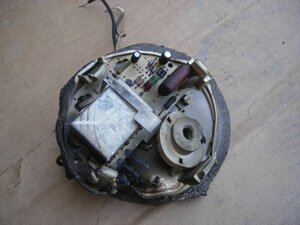
By the time this ionization detector sounded at the North Berkshire Road duplex during an early-morning May 12 fire, smoke and flames nearly prevented a sleeping man from escaping.
PHOTO BY COURTENEY STUART

"I still think about it," said John Carter, who was sleeping in the downstairs of the split-level duplex when the fire broke out. He was pulled through the ground-level window by firefighters.
PHOTO BY COURTENEY STUART
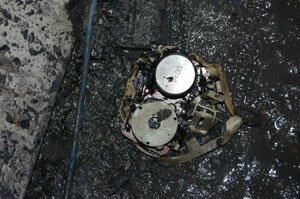
The ionization detector at Lewis Mountain Road did sound during the fatal March 18, 2007 fire. Resident Mark Allen says by the time it awakened him, smoke was thick and flames were spreading. Allen escaped, but 25-year-old Brett Quarterman died, and his girlfriend, Ashley Mauter, suffered severe burns.
PHOTO COURTESY CHARLOTTESVILLE FIRE DEPARTMENT
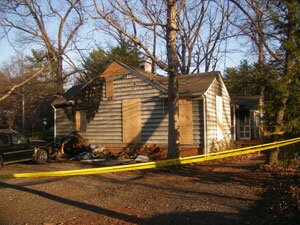
No cause was ever determined for the fire at 2015 Lewis Mountain Road.
FILE PHOTO BY HAWES SPENCER
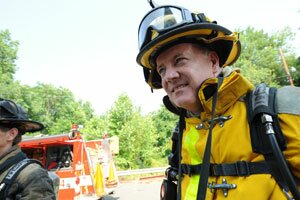
Ionization detectors "aren't smoke detectors," says Jay Fleming. "They're fire detectors."
PHOTO BY JEN FARIELLO

"I'm on a one-man mission to save as many lives as possible," says Boston Deputy Fire Chief Jay Fleming. The Hook brought Fleming to Charlottesville for the June 10 smoke detector test in the local fire training facility behind the Albemarle Charlottesville Regional Jail on Avon Street.
PHOTO BY JEN FARIELLO
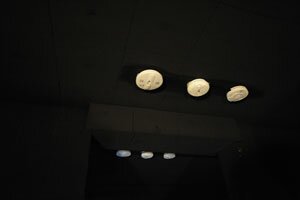
The Hook's smoke detector test used two of each type of detector– ionization, photoelectric, and combination. One of each was affixed to the ceiling inside the room where the fire was set; another set of three was attached to the ceiling immediately outside a doorless opening inside the burn center.
PHOTO BY COURTENEY STUART
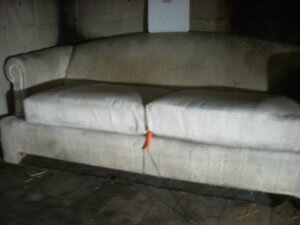
9:49– A soldering iron is inserted between couch cushions to ignite a smoldering fire.
PHOTO BY HAWES SPENCER

9:54am– A thin plume of smoke snakes toward the ceiling.
PHOTO BY HAWES SPENCER
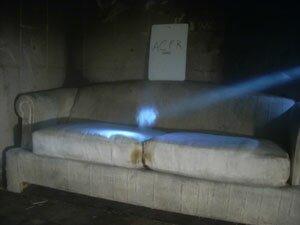
10:15– Both photoelectric detectors sound; three minutes later, the combination alarms go off.
PHOTO BY HAWES SPENCER
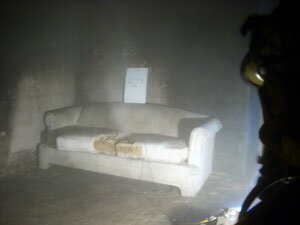
11:51– Nearly two hours after the smoldering fire was set– and more than an hour after the building's carbon monoxide detectors sounded– the ionization detectors remain silent. They won't go off until actual flames appear.
PHOTO BY HAWES SPENCER
